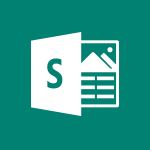Sway - Formatting a Sway created from a file Video
In this video, you will learn about Microsoft Sway and how to format a Sway created from a file.
The video covers the process of adding titles, headings, texts, images, and videos to your Sway.
You can insert content from your computer, OneDrive, or YouTube.
Organizing your items in a group is also demonstrated.
The video emphasizes the importance of checking how your Sway will look when viewed by others and provides options for sharing your creation on social media platforms or through embedded links.
This tutorial will help you optimize your Sway formatting skills and enhance your SEO visibility.
- 2:18
- 2500 views
-
Sway - Creating a Sway template
- 0:55
- Viewed 6177 times
-
Sway - Viewing your first presentation
- 0:57
- Viewed 2411 times
-
Sway - Creating a Sway from a file
- 0:38
- Viewed 2418 times
-
Sway - Formatting a Sway created from a file
- 2:18
- Viewed 2500 times
-
Sway - Adding other types of content
- 0:56
- Viewed 2570 times
-
Sway - Customising and remixing your Sway
- 1:22
- Viewed 2268 times
-
Sway - Removing the Sway informational footer
- 0:35
- Viewed 2353 times
-
Sway - Preventing particular users from using Sway
- 0:47
- Viewed 2300 times
-
Creating a Sway template
- 0:55
- Viewed 6177 times
-
Enabling autoplay
- 0:42
- Viewed 4575 times
-
Exporting a Sway
- 0:48
- Viewed 4114 times
-
Duplicating and deleting a Sway
- 0:49
- Viewed 3854 times
-
Adding and recording an audio file
- 1:12
- Viewed 2942 times
-
Creating a title with a background image
- 1:38
- Viewed 2882 times
-
Managing external sharing and external content
- 0:58
- Viewed 2707 times
-
Sharing a Sway
- 1:41
- Viewed 2699 times
-
Copying cards from one Sway to another
- 0:44
- Viewed 2687 times
-
Adding other types of content
- 0:56
- Viewed 2570 times
-
Introduction to the application
- 1:25
- Viewed 2543 times
-
Embedding video content
- 0:51
- Viewed 2522 times
-
Creating a heading and a text card
- 1:21
- Viewed 2494 times
-
Creating a Sway from a file
- 0:38
- Viewed 2418 times
-
Viewing your first presentation
- 0:57
- Viewed 2411 times
-
Accessing the application
- 0:30
- Viewed 2370 times
-
Removing the Sway informational footer
- 0:35
- Viewed 2353 times
-
Preventing particular users from using Sway
- 0:47
- Viewed 2300 times
-
Adding a Stack group card
- 1:37
- Viewed 2295 times
-
Dragging and dropping an image into an image card
- 0:29
- Viewed 2283 times
-
Customising and remixing your Sway
- 1:22
- Viewed 2268 times
-
Introduction to Sway
- 1:17
- Viewed 2213 times
-
Printing a Sway
- 0:19
- Viewed 2205 times
-
Creating and modifying a Sway from the Office 365 Home page
- 0:34
- Viewed 2195 times
-
Creating a Sway in just a few seconds
- 0:45
- Viewed 2158 times
-
Copying a chart in Sway
- 0:45
- Viewed 2045 times
-
Playing a card using the Design tab
- 0:20
- Viewed 1566 times
-
Introduction to Sway
- 01:53
- Viewed 142 times
-
Introduction to PowerBI
- 00:60
- Viewed 167 times
-
Introduction to Microsoft Outlook
- 01:09
- Viewed 158 times
-
Introduction to Microsoft Insights
- 02:04
- Viewed 155 times
-
Introduction to Microsoft Viva
- 01:22
- Viewed 161 times
-
Introduction to Planner
- 00:56
- Viewed 169 times
-
Introduction to Microsoft Visio
- 02:07
- Viewed 158 times
-
Introduction to Microsoft Forms
- 00:52
- Viewed 164 times
-
Introducing to Microsoft Designer
- 00:28
- Viewed 224 times
-
Introduction to Sway
- 01:53
- Viewed 142 times
-
Introducing to Word
- 01:00
- Viewed 165 times
-
Introducing to SharePoint Premium
- 00:47
- Viewed 147 times
-
Create a call group
- 01:15
- Viewed 200 times
-
Use call delegation
- 01:07
- Viewed 128 times
-
Assign a delegate for your calls
- 01:08
- Viewed 200 times
-
Ring multiple devices simultaneously
- 01:36
- Viewed 136 times
-
Use the "Do Not Disturb" function for calls
- 01:28
- Viewed 126 times
-
Manage advanced call notifications
- 01:29
- Viewed 141 times
-
Configure audio settings for better sound quality
- 02:08
- Viewed 173 times
-
Block unwanted calls
- 01:24
- Viewed 140 times
-
Disable all call forwarding
- 01:09
- Viewed 141 times
-
Manage a call group in Teams
- 02:01
- Viewed 132 times
-
Update voicemail forwarding settings
- 01:21
- Viewed 130 times
-
Configure call forwarding to internal numbers
- 01:02
- Viewed 123 times
-
Set call forwarding to external numbers
- 01:03
- Viewed 148 times
-
Manage voicemail messages
- 01:55
- Viewed 187 times
-
Access voicemail via mobile and PC
- 02:03
- Viewed 205 times
-
Customize your voicemail greeting
- 02:17
- Viewed 125 times
-
Transfer calls with or without an announcement
- 01:38
- Viewed 121 times
-
Manage simultaneous calls
- 01:52
- Viewed 131 times
-
Support third-party apps during calls
- 01:53
- Viewed 160 times
-
Add participants quickly and securely
- 01:37
- Viewed 132 times
-
Configure call privacy and security settings
- 02:51
- Viewed 130 times
-
Manage calls on hold
- 01:20
- Viewed 137 times
-
Live transcription and generate summaries via AI
- 03:43
- Viewed 126 times
-
Use the interface to make and receive calls
- 01:21
- Viewed 131 times
-
Action Function
- 04:18
- Viewed 138 times
-
Search Function
- 03:42
- Viewed 188 times
-
Date and Time Function
- 02:53
- Viewed 168 times
-
Logical Function
- 03:14
- Viewed 255 times
-
Text Function
- 03:25
- Viewed 199 times
-
Basic Function
- 02:35
- Viewed 158 times
-
Categories of Functions in Power FX
- 01:51
- Viewed 188 times
-
Introduction to Power Fx
- 01:09
- Viewed 159 times
-
The New Calendar
- 03:14
- Viewed 282 times
-
Sections
- 02:34
- Viewed 171 times
-
Customizing Views
- 03:25
- Viewed 165 times
-
Introduction to the New Features of Microsoft Teams
- 00:47
- Viewed 271 times
-
Guide to Using the Microsoft Authenticator App
- 01:47
- Viewed 186 times
-
Turn on Multi-Factor Authentication in the Admin Section
- 02:07
- Viewed 145 times
-
Concept of Multi-Factor Authentication
- 01:51
- Viewed 172 times
-
Retrieve Data from a Web Page and Include it in Excel
- 04:35
- Viewed 392 times
-
Create a Desktop Flow with Power Automate from a Template
- 03:12
- Viewed 334 times
-
Understand the Specifics and Requirements of Desktop Flows
- 02:44
- Viewed 206 times
-
Dropbox: Create a SAS Exchange Between SharePoint and Another Storage Service
- 03:34
- Viewed 349 times
-
Excel: List Files from a Channel in an Excel Workbook with Power Automate
- 04:51
- Viewed 222 times
-
Excel: Link Excel Scripts and Power Automate Flows
- 03:22
- Viewed 228 times
-
SharePoint: Link Microsoft Forms and Lists in a Power Automate Flow
- 04:43
- Viewed 404 times
-
SharePoint: Automate File Movement to an Archive Library
- 05:20
- Viewed 199 times
-
Share Power Automate Flows
- 02:20
- Viewed 193 times
-
Manipulate Dynamic Content with Power FX
- 03:59
- Viewed 196 times
-
Leverage Variables with Power FX in Power Automate
- 03:28
- Viewed 184 times
-
Understand the Concept of Variables and Loops in Power Automate
- 03:55
- Viewed 196 times
-
Add Conditional “Switch” Actions in Power Automate
- 03:58
- Viewed 232 times
-
Add Conditional “IF” Actions in Power Automate
- 03:06
- Viewed 168 times
-
Create an Approval Flow with Power Automate
- 03:10
- Viewed 361 times
-
Create a Scheduled Flow with Power Automate
- 01:29
- Viewed 584 times
-
Create an Instant Flow with Power Automate
- 02:18
- Viewed 338 times
-
Create an Automated Flow with Power Automate
- 03:28
- Viewed 328 times
-
Create a Simple Flow with AI Copilot
- 04:31
- Viewed 306 times
-
Create a Flow Based on a Template with Power Automate
- 03:20
- Viewed 274 times
-
Discover the “Build Space”
- 02:26
- Viewed 192 times
-
The Power Automate Mobile App
- 01:39
- Viewed 200 times
-
Familiarize Yourself with the Different Types of Flows
- 01:37
- Viewed 193 times
-
Understand the Steps to Create a Power Automate Flow
- 01:51
- Viewed 282 times
-
Discover the Power Automate Home Interface
- 02:51
- Viewed 187 times
-
Access Power Automate for the Web
- 01:25
- Viewed 298 times
-
Understand the Benefits of Power Automate
- 01:30
- Viewed 245 times
Objectifs :
This document aims to provide a comprehensive guide on organizing an imported presentation using Sway, focusing on the manipulation of cards, grouping images and texts, and utilizing various slideshow features.
Chapitres :
-
Introduction to Organizing Presentations
In this section, we will explore how to effectively organize an imported presentation in Sway. The goal is to enhance the visual structure and flow of your presentation by utilizing different card types and grouping functionalities. -
Understanding Card Structures
When working with imported presentations, you may encounter cards with different structures. For instance, you might have image cards and text cards that need to be organized cohesively. To begin, you can drag an image card into a designated box, which will embed the image within the presentation. -
Grouping Texts and Images
To improve the presentation's readability, consider copying and pasting texts to group them on the same card. This method allows for a smoother transition between ideas rather than jumping from card to card. Additionally, you can group images by dragging two image cards together, which will automatically create a group. -
Changing Group Types
Once a group is created, you have the option to change its type. There are several grouping options available: - **Automatic Group**: Places images side by side. - **Stack Feature**: Allows users to scroll through images one after the other. - **Grid Layout**: Organizes images into a grid format, which is particularly useful when you have multiple images. -
Utilizing Slideshow Features
Sway offers three types of slideshows to enhance your presentation: 1. **Scrolling Slideshow**: Enables users to scroll through images seamlessly. 2. **Thumbnail Slideshow**: Displays images as thumbnails, ideal for continuous image presentations. 3. **Comparison Feature**: Allows for side-by-side comparison by dragging and dropping images. -
Formatting Imported Charts
If you have imported a chart as an image, it is essential to format it correctly within your Sway presentation. This ensures that the chart is visually appealing and easy to understand for your audience. -
Conclusion
In summary, organizing an imported presentation in Sway involves understanding card structures, effectively grouping texts and images, and utilizing various slideshow features. By following these guidelines, you can create a more engaging and visually appealing presentation that effectively communicates your message.
FAQ :
How do I organize an imported presentation?
You can organize an imported presentation by dragging and dropping cards into designated areas, grouping similar content, and choosing different layout options for better presentation.
What is the purpose of grouping cards?
Grouping cards allows you to combine related content, making it easier to present and view information cohesively.
What are the different types of slideshows available?
There are three types of slideshows: one that allows scrolling through images, one that displays images as thumbnails, and a comparison feature for side-by-side viewing.
Can I edit the cards after importing a presentation?
Yes, you can edit the different cards after importing a presentation, allowing you to format and arrange content as needed.
What does the stack feature do?
The stack feature allows you to scroll through images one at a time, providing a focused viewing experience.
Quelques cas d'usages :
Creating a Marketing Presentation
Use the card organization and grouping features to create a visually appealing marketing presentation that highlights product images and descriptions effectively.
Educational Slide Decks
Organize educational content by grouping related text and images, making it easier for students to follow along during presentations.
Comparative Analysis Reports
Utilize the comparison feature to present data side by side, allowing for clear visual comparisons in reports or presentations.
Portfolio Showcases
Create a portfolio by grouping images and descriptions of your work, using the grid layout for a clean and professional presentation.
Event Recaps
Compile images and texts from an event into a cohesive presentation, using the slideshow feature to narrate the event's highlights.
Glossaire :
Card
A card is a distinct unit within a presentation that can contain various types of content, such as images or text.
Drag and Drop
A user interface action that allows users to select an item and move it to a different location by clicking and holding the mouse button.
Group
A collection of cards that are combined to display content together, allowing for better organization and presentation.
Stack Feature
A presentation option that allows users to scroll through images one after the other, creating a sequential viewing experience.
Grid
A layout option that organizes images into a structured grid format, allowing for a neat and organized display.
Slideshow
A presentation format that allows users to view images in a sequence, with different styles such as scrolling or thumbnail views.
Comparison Feature
A functionality that enables users to drag and drop elements to compare them side by side.




